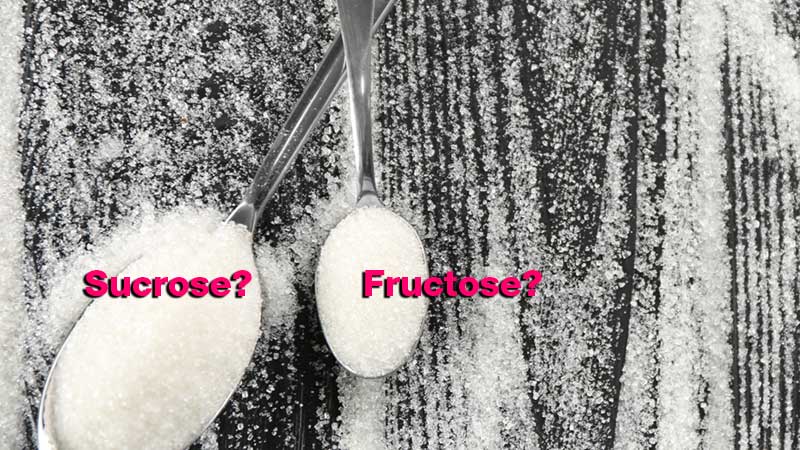
Are glucose and fructose the same? Yes, and no. These sugars both negatively impact health and fitness but can do so in different ways.
In nature, glucose and fructose are the primary sugars. Both are found in varying amounts and ratios in fruit and honey, for example.
Glucose has been researched for more than 200 years, and its use has been a topic discussed by athletes and coaches, nutritionists, doctors and other experts.
In recent decades, fructose also has been a source of much discussion. It was initially believed to be safer because of its lower glycemic index, but was later implicated in other health issues. In addition, most fructose is made from corn, which is processed to produce a syrup high in fructose, called “high-fructose corn syrup,” which still contains some glucose. Agave, another source, is almost all fructose.
Both glucose and fructose are found in many natural foods, as separate simple sugars (monosaccharides) in fruits and honey, or together as a disaccharide, such as in table sugar (sucrose) and maple syrup.
Other types of sugars include galactose, a less-sweet component of the milk sugar, lactose. Less frequently discussed are sugars like raffinose and stachyose found in beans.
While there are many types of sugars, glucose and fructose stand out as the main contributors to ill health and the global overfat pandemic. These sugars are the two most commonly added to junk food and drinks such as soda.
The topic of excess sugar consumption is addressed in many articles on this website, especially describing its direct and powerful effect on insulin, which converts 40-50 percent of consumed sugar into stored fat and encourages body fat to be redeposited in the abdomen. This is particularly true of glucose.
Fructose can affect health in different ways compared to glucose. While it too can increase stores of body fat, it can in addition harm the liver and worsen cardiac health by raising triglycerides.
These sugars are consumed at very high levels globally as they are added to most packaged and junk foods. Average daily consumption of added sugar for men (335 calories) and women (230 calories) exceeds recommendations even by the conservative American Heart Association of 150 and 100 calories, respectively.
The notion of “added sugars” is one that differentiates those that normally occur in foods. However, processed carbohydrates are usually higher glycemic, converting in the body to the same simple sugars glucose and fructose soon after eating. This is why eating junk food can essentially be the same as — or even worse than — eating pure refined sugar.
Both glucose and fructose are also very sweet-tasting. This is the reason one or both are added to most packaged foods. These are not just the obvious sweet food items like cakes and cookies, but tomato sauce, mayonnaise and yogurt as well. In addition, various concentrated forms are available for consumption or for adding to your own recipes, from dry white sugar to sweet syrups.
The result has been an explosion of sugar consumption over the past 40 years, with the average American consuming a whopping 66 pounds annually — with similar rates in other countries. Added sugars, not fat, are the main reason people consume more calories. Together with its metabolic effects, including conversion of up to 50 percent into stored fat, sugar may be the primary contributor of the global overfat pandemic.
Fructose
High-fructose corn syrup has been getting a bad rap in recent years. Deservedly so. After a period in the early 1980s when it was deemed a healthier form of sugar because of its low glycemic index, it was soon discovered that excess fructose could be as dangerous as glucose through other biological mechanisms.
To put it in perspective, overconsumption of fructose can cause many of the same health problems as excessive alcohol, including increased blood pressure, abnormal cholesterol and triglyceride levels, insulin resistance, liver dysfunction, along with the most common one associated with glucose — increased body fat.
Unlike glucose, fructose is converted to fat in the liver, the reason it’s associated with nonalcoholic fatty liver disease. This also raises blood levels of triglycerides leading to added fat deposits in the abdomen and muscles, even more than glucose. While fructose may not stimulate insulin like glucose, through other mechanisms it can still lead to insulin resistance, impaired glucose tolerance, and hyperinsulinemia.
Fructose consumption from beverages, in particular, along with other junk-food sugars, has created poor health in unique ways. The increased caloric intake associated with the overfat pandemic is significantly due to fructose calories in soft drinks. Sugar-sweetened beverages are usually high in fructose in the U.S. (although in many countries sucrose is still the preferred soft-drink sweetener).
Writing in the New England Journal of Medicine (Calories from Soft Drinks — Do They Matter? 2012), Dr. Sonia Caprio, Department of Pediatrics, Yale School of Medicine, states: “The time has come to take action and strongly support and implement the recommendations from the Institute of Medicine, the American Heart Association, the Obesity Society, and many other organizations to reduce consumption of sugar-sweetened beverages in both children and adults.”
The Leptin Link
Leptin is a hormone that reduces hunger, but fructose reduces leptin levels. So even though you just consumed a big beverage sweetened with high-fructose corn syrup, you’re still hungry for more sugar. This is double-trouble, as fructose stimulates an area in the brain called the nucleus accumbens, which increases reward, ensuring a continued cycle called addiction.
The Big Sugar Conspiracy
Consuming table sugar (sucrose) and high-fructose corn syrup both contribute to the intake of fructose. The Big Sugar syndicate and junk-food industry have long known of the unique addictive features of fructose, and take advantage of it much the same way Big Tobacco got people hooked on cigarettes. It’s one way that fructose leads to weight gain and its associated metabolic consequence — when people eat it, they almost always eat more.
The Good News
If there’s any good news in all this, it’s that you have control over it. The simple act of removing added fructose from your diet, like removing glucose, can bring about dramatic effects. This is best seen in Two Week Test results, where people lose significant weight and body fat, reduce triglycerides and cholesterol, lower blood pressure and improve brain function very quickly.
This simple act can yield quick results. A recent study showed that obese children with metabolic syndrome who reduced added fructose for only nine days had immediate and dramatic reductions in blood pressure, triglycerides, and LDL-cholesterol with improved glucose tolerance and hyperinsulinemia
Yet recommendations based on studies like this remain virtually anemic compared to the billion-dollar annual budgets of soda-company advertisements urging people to drink up, much like Joe Camel encouraged smoking.








